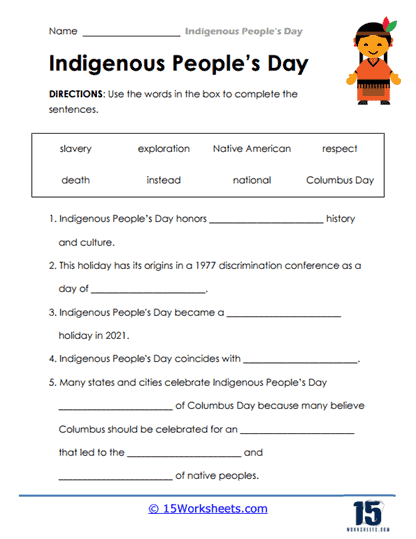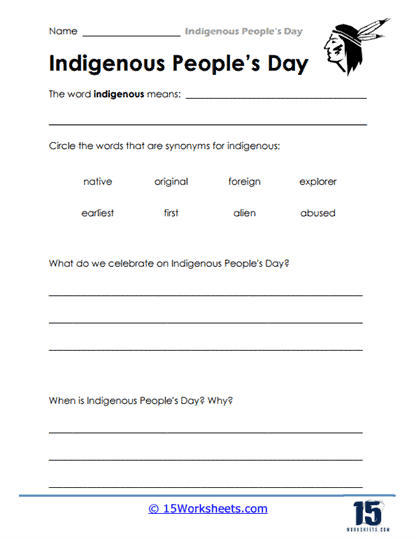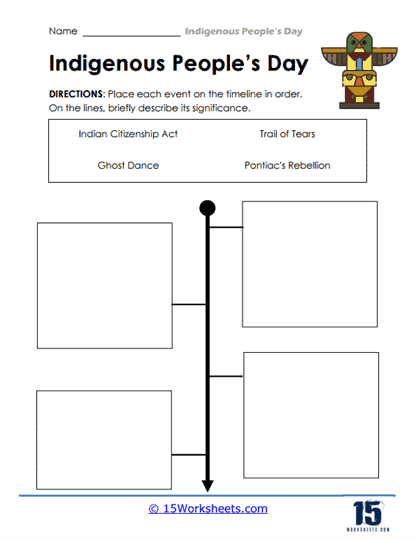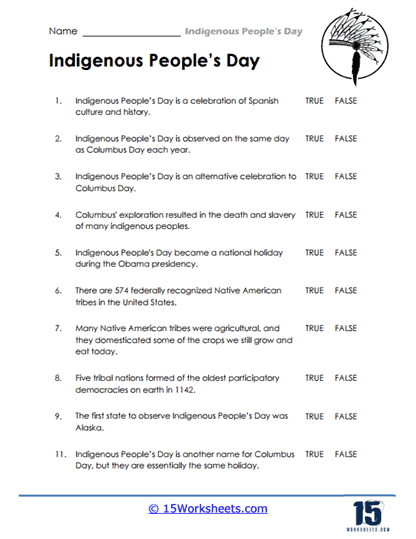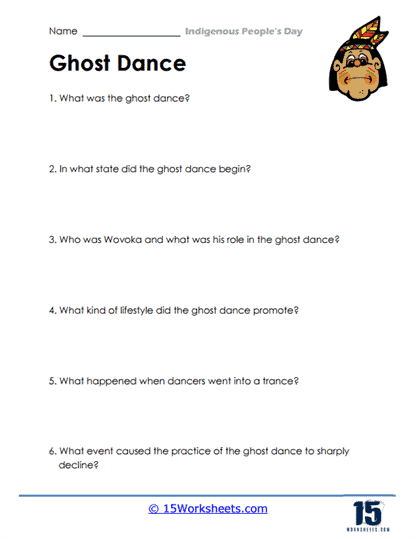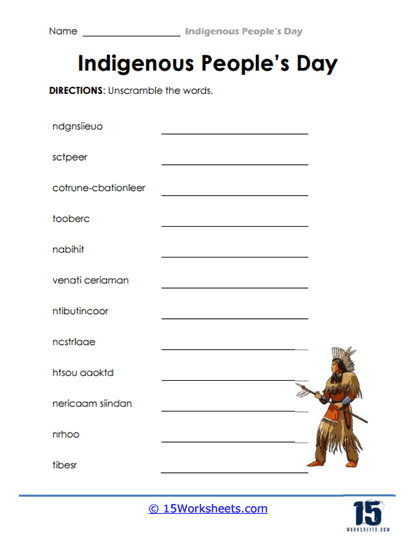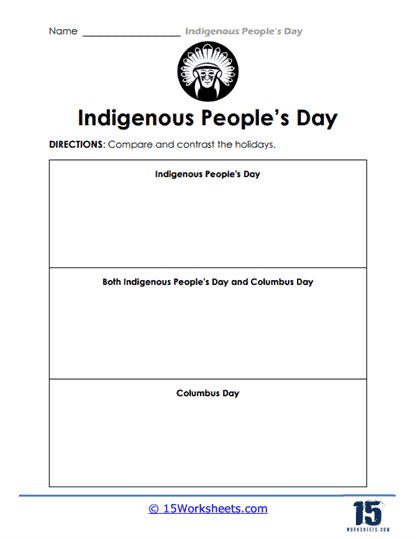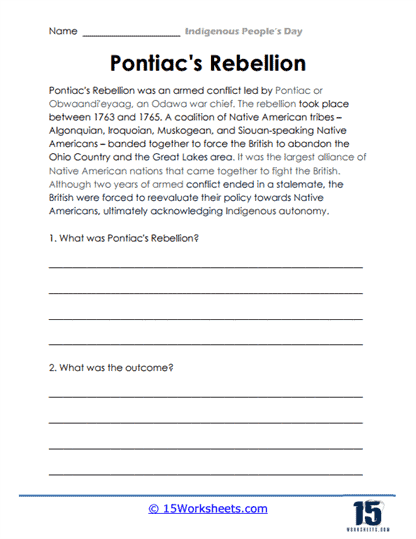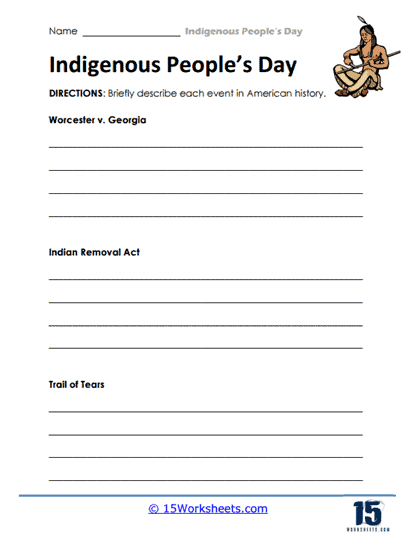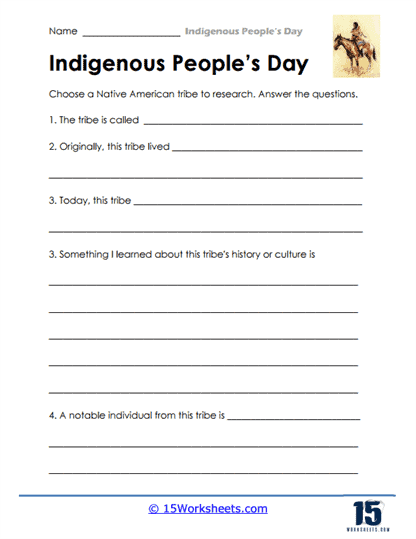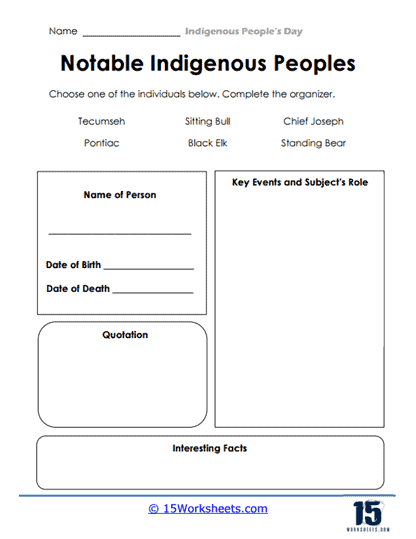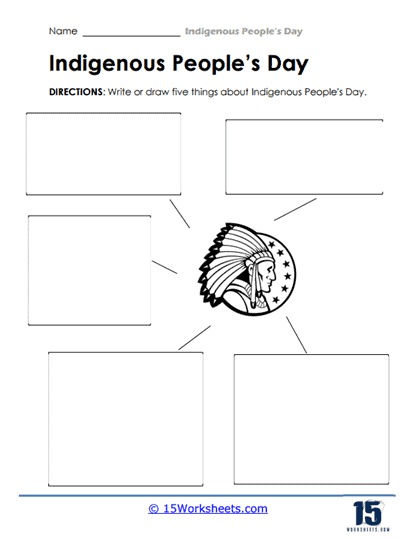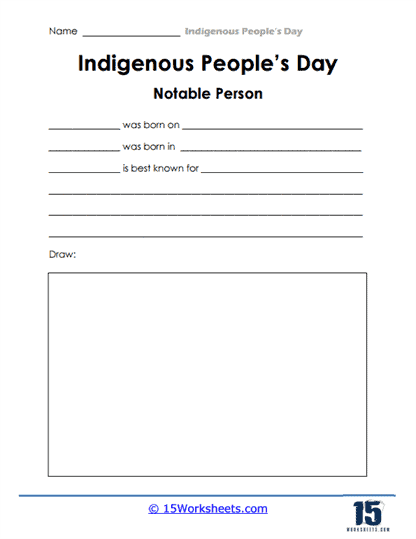Indigenous People's Day Worksheets
About These 15 Worksheets
These worksheets aim to promote awareness and understanding of the rich heritage, traditions, and contemporary issues faced by Indigenous peoples around the world. They can be used in schools, community centers, and educational settings to foster cultural appreciation and respect for Indigenous cultures and histories.
Here are some common elements found in Indigenous People’s Day worksheets:
Indigenous Cultures – Worksheets may explore the cultures and traditions of various Indigenous communities, including their art, music, dance, language, and storytelling.
History and Heritage – Students may learn about the history of Indigenous peoples, their ancient civilizations, and their interactions with European settlers and colonizers.
Notable Indigenous Figures – Worksheets might feature profiles of significant Indigenous leaders, activists, artists, writers, and historical figures who have made important contributions to their communities and society at large.
Current Issues – Students may be introduced to contemporary challenges faced by Indigenous peoples, such as land rights, environmental issues, cultural preservation, and social justice.
Native American Tribes – Worksheets could focus on specific Native American tribes, exploring their unique cultures, territories, and historical experiences.
Native Languages – Students might have opportunities to learn basic words and phrases in Indigenous languages to promote linguistic diversity. Students may explore traditional Indigenous myths, legends, and creation stories, which often carry valuable cultural teachings.
The aim of Indigenous People’s Day worksheets is to challenge historical inaccuracies and stereotypes about Indigenous peoples and to foster an appreciation for their diverse cultures and contributions to society. These educational materials can play a vital role in promoting cultural sensitivity, empathy, and understanding, while also empowering Indigenous students to take pride in their heritage and identity. Indigenous People’s Day worksheets can be found through educational websites, cultural organizations, and resources dedicated to promoting Indigenous knowledge and representation.
What is Indigenous People’s Day?
Indigenous People’s Day is an observance dedicated to honoring and recognizing the history, culture, and contributions of Indigenous peoples around the world. It serves as an alternative to Columbus Day, challenging the traditional narrative surrounding Christopher Columbus’s arrival in the Americas and reorienting the focus towards the rich and diverse heritage of Indigenous communities. This essay will delve into the reasons behind celebrating Indigenous People’s Day, the historical context, and the deep facts that underline its significance. Additionally, we will explore the difference between Indigenous People’s Day and Native American Day, shedding light on the distinctions and purposes of each observance.
Challenging the Columbus Day Narrative
Indigenous People’s Day emerged as a response to the widely celebrated Columbus Day, which traditionally commemorates Christopher Columbus’s arrival in the Americas on October 12, 1492. For decades, Columbus Day was celebrated as a symbol of exploration and discovery, attributing Columbus with the “discovery” of the New World. However, this perspective perpetuates a Eurocentric viewpoint, disregarding the presence and rich civilizations of Indigenous peoples who had inhabited the Americas for millennia.
As scholarship and historical awareness grew, it became evident that Columbus’s arrival marked the beginning of a devastating era of colonization, violence, and forced assimilation that resulted in the decimation of Indigenous populations. Celebrating Columbus Day disregards the suffering and loss experienced by Indigenous communities and perpetuates historical inaccuracies.
Honoring Indigenous Cultures and Contributions
Indigenous People’s Day serves as an opportunity to recognize the vibrant cultures, traditions, and contributions of Indigenous peoples. Throughout history, Indigenous communities have made significant advancements in agriculture, astronomy, art, medicine, and environmental stewardship. By celebrating Indigenous People’s Day, we highlight the resilience, knowledge, and wisdom that these communities have preserved and passed down through generations.
Fostering Cultural Understanding and Reconciliation
The observance of Indigenous People’s Day aims to foster cultural understanding and promote reconciliation between Indigenous and non-Indigenous communities. By acknowledging the historical injustices and the ongoing challenges faced by Indigenous peoples, society can work towards a more inclusive and equitable future. It provides a platform to learn from the experiences of Indigenous communities and recognize their rightful place in the collective history of the Americas.
The History and Deep Facts Behind Indigenous People’s Day
The origins of Indigenous People’s Day can be traced back to the early 1970s. In 1977, a delegation of Native nations proposed the replacement of Columbus Day with Indigenous People’s Day at the United Nations International Conference on Discrimination against Indigenous Populations in the Americas. However, the push for this change gained significant momentum in the late 20th and early 21st centuries as awareness of Indigenous issues grew, and social justice movements gained traction.
The city of Berkeley, California, was one of the pioneers in adopting Indigenous People’s Day. In 1992, on the 500th anniversary of Columbus’s arrival, Berkeley declared October 12 as a “Day of Solidarity with Indigenous People” to honor Native American cultures and history. Subsequently, numerous cities, towns, and states across the United States followed suit, officially recognizing Indigenous People’s Day or renaming Columbus Day to reflect a more inclusive perspective.
Indigenous Activism and Advocacy
The emergence of Indigenous People’s Day is deeply connected to the activism and advocacy efforts of Indigenous communities. Indigenous leaders and organizations have long fought for recognition of their rights, lands, and cultures. Their persistent efforts have contributed to raising awareness about the historical injustices they have endured and the ongoing challenges they face.
Additionally, social movements like the American Indian Movement (AIM) played a significant role in bringing attention to Indigenous issues and promoting the idea of reclaiming Indigenous heritage and history. Through grassroots organizing, protests, and education campaigns, Indigenous activists have been instrumental in pushing for the recognition of Indigenous People’s Day.
International Recognition
Beyond the United States, Indigenous People’s Day has gained international recognition as a day to celebrate and honor the world’s Indigenous populations. Several countries have adopted similar observances, each tailored to their own Indigenous communities and histories. For example, in Bolivia, the day was officially established as “Día del Respeto a la Diversidad Cultural” (Day of Respect for Cultural Diversity) to recognize the country’s Indigenous heritage.
The Difference Between Indigenous People’s Day and Native American Day:
Although both Indigenous People’s Day and Native American Day are related to the recognition and celebration of Indigenous communities, they are distinct observances with different historical backgrounds and contexts.
Indigenous People’s Day
Indigenous People’s Day, as mentioned earlier, is an alternative to Columbus Day and aims to recognize the contributions, resilience, and cultures of Indigenous peoples from various regions, not just limited to the Americas. It is a broader observance that emphasizes inclusivity and celebrates Indigenous populations from around the world.
Native American Day
Native American Day is a specific observance that primarily focuses on celebrating the contributions and cultures of Native American communities in the United States. It is often observed on the fourth Friday in September, and some states, such as California, South Dakota, and Nevada, have officially recognized it as a state holiday.
The establishment of Native American Day was influenced by the activism of Indigenous leaders and communities in the mid-20th century. The first official Native American Day was celebrated in California in 1968 after then-Governor Ronald Reagan signed a resolution in honor of Native American cultures and contributions.
In contrast to Indigenous People’s Day, which seeks to address the broader issues of historical representation and colonization, Native American Day specifically highlights the unique histories and cultures of Native American communities within the United States.


